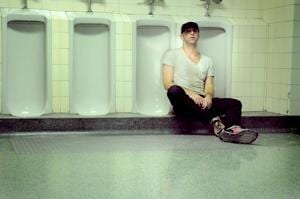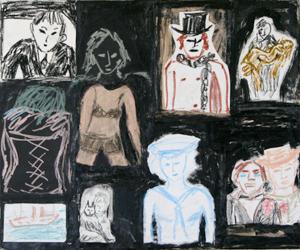
In Flagrante. Credit: Drasko Bogdanovic
Sarah Hunter knew she was a lesbian at the age of four. But it took another 45 years for her to come out.
“Even though I was around gay people growing up, they weren’t able to own it,” the Toronto-born artist says. “My father eventually came out later in life as gay, but growing up I was surrounded by internalized homophobia.
“It was also a very sexist environment where women were nothing,”she adds. “If I’d had better role models in terms of being female and in terms of being queer, maybe it wouldn’t have taken me so long to fully understand who I was.”
The former art teacher and current arts administrator’s late-life coming out process provided the fodder for her new body of work, being presented as part of the Raw Me exhibition at Bezpala Brown Gallery this month. The show features a diverse group of queer artists, including Nickolas Hadzis, Francis Luta and Donald Vaillancourt.
Also featured are a selection of photographs from Drasko Bogdanovic deemed too hot for his exhibition at Riverdale’s Hang Man Gallery in April. Though Raw Me is the only entirely queer show at the upstart St Lawrence Market space to date, any controversy it generates will not be the first. The gallery last made waves in February with Hungarian-born artist Peter Alexander Por’s paintings, which included (among other things) a hole-riddled Pope Benedict XVI and a crucified Barack Obama.
Hunter’s work relies more on subtlety than shock. Her expressionistic collection of paintings, drawings and collages explores inner landscape by drawing on images from films, dreams and myths. She frequently focuses on the relationship between humans and the natural world. While “coming-out art” often conjures images of naked bodies and rainbow flags, Hunter is more interested in the subconscious elements of sexuality, perhaps because of how she came to understand her identity.
“My husband and I were struggling in our marriage and had decided to go to counselling,” she says. “During a session I was talking with my therapist about gender roles. Suddenly something clicked and I realized I was gay. There were so many things that had never made sense, but when I found this piece of the puzzle that made everything fit together.”
Hunter split up with her husband shortly after that, though the two remain good friends. She joined a coming-out group at the 519 Community Centre on the advice of her therapist, where she met Fariz Kovalchuk (another artist featured in the exhibition, who also manages the gallery).
“It’s a very big group, usually about 30 people at each meeting,” Hunter says. “People are dealing with all kinds of issues there, but what unites almost all of us is the need to connect with a community of queers.
“When I first came out I felt like a teenager, even though I was almost 50,” she adds. “I really wanted to find ways to be a part of the community. A lot of queer spaces are mostly male, so I ended up gravitating towards gay men.”
When Hunter eventually made her first lesbian outing, she was in for a huge surprise. While attending a women’s event at Slack’s, she unexpectedly encountered a bunch of familiar faces.
“I saw this group of women I knew who had all been married to men, like me,” she says. “I had known them for years, and our kids had played together while they were growing up. When I went over to say hello, one of them said they had been wondering how long it would be before they finally saw me there. I guess all of them knew I was gay before I did.”


 Why you can trust Xtra
Why you can trust Xtra


